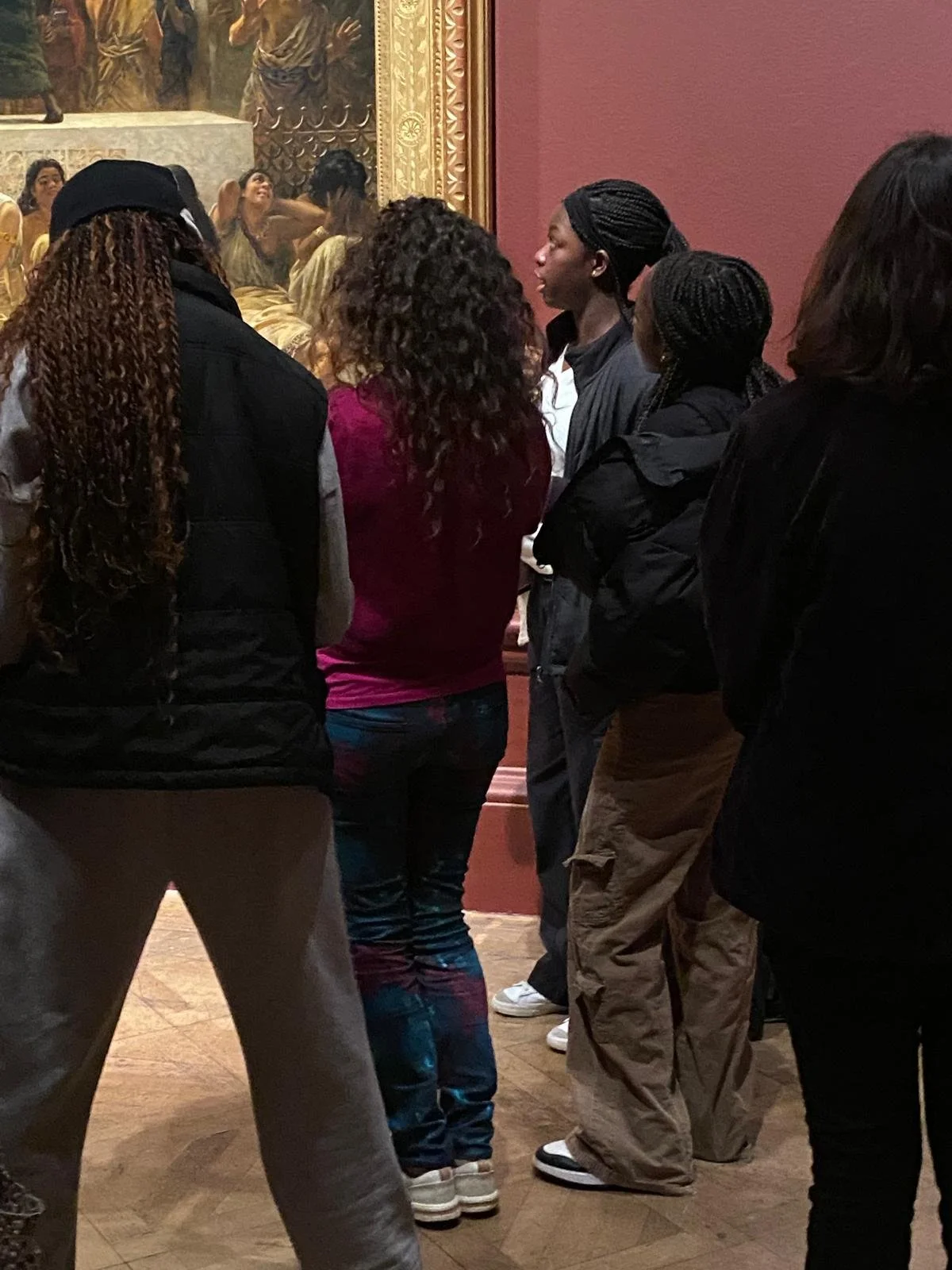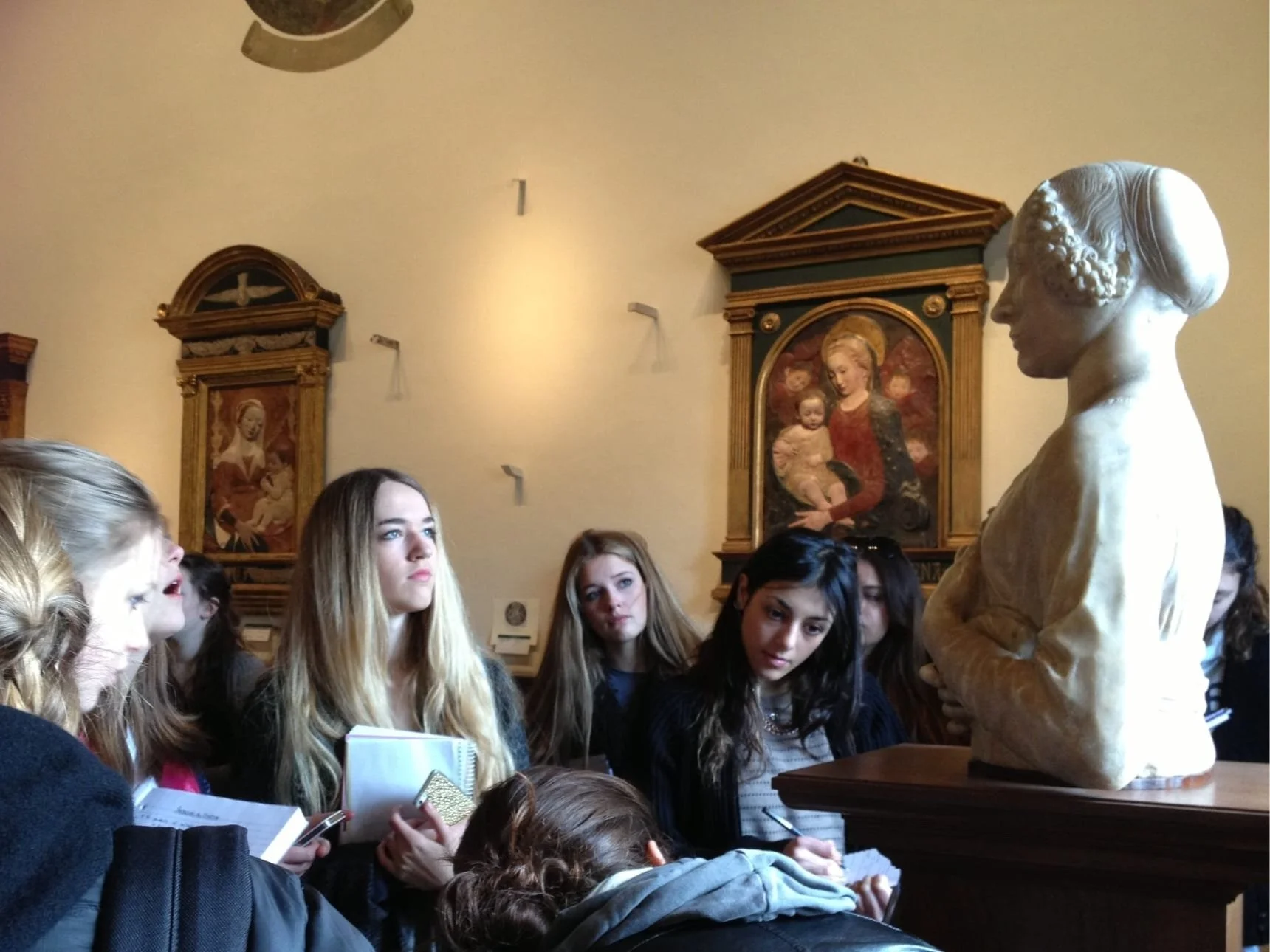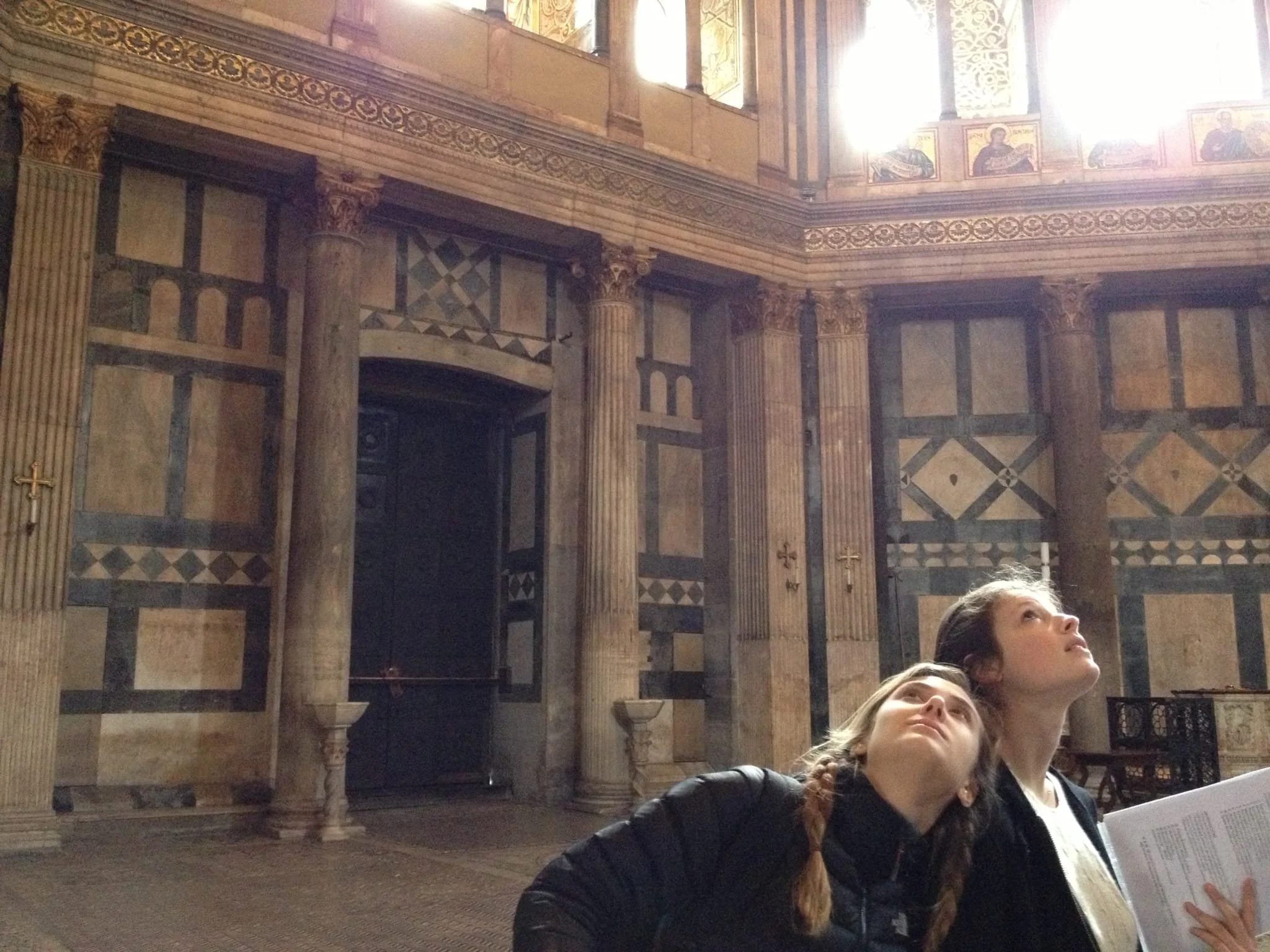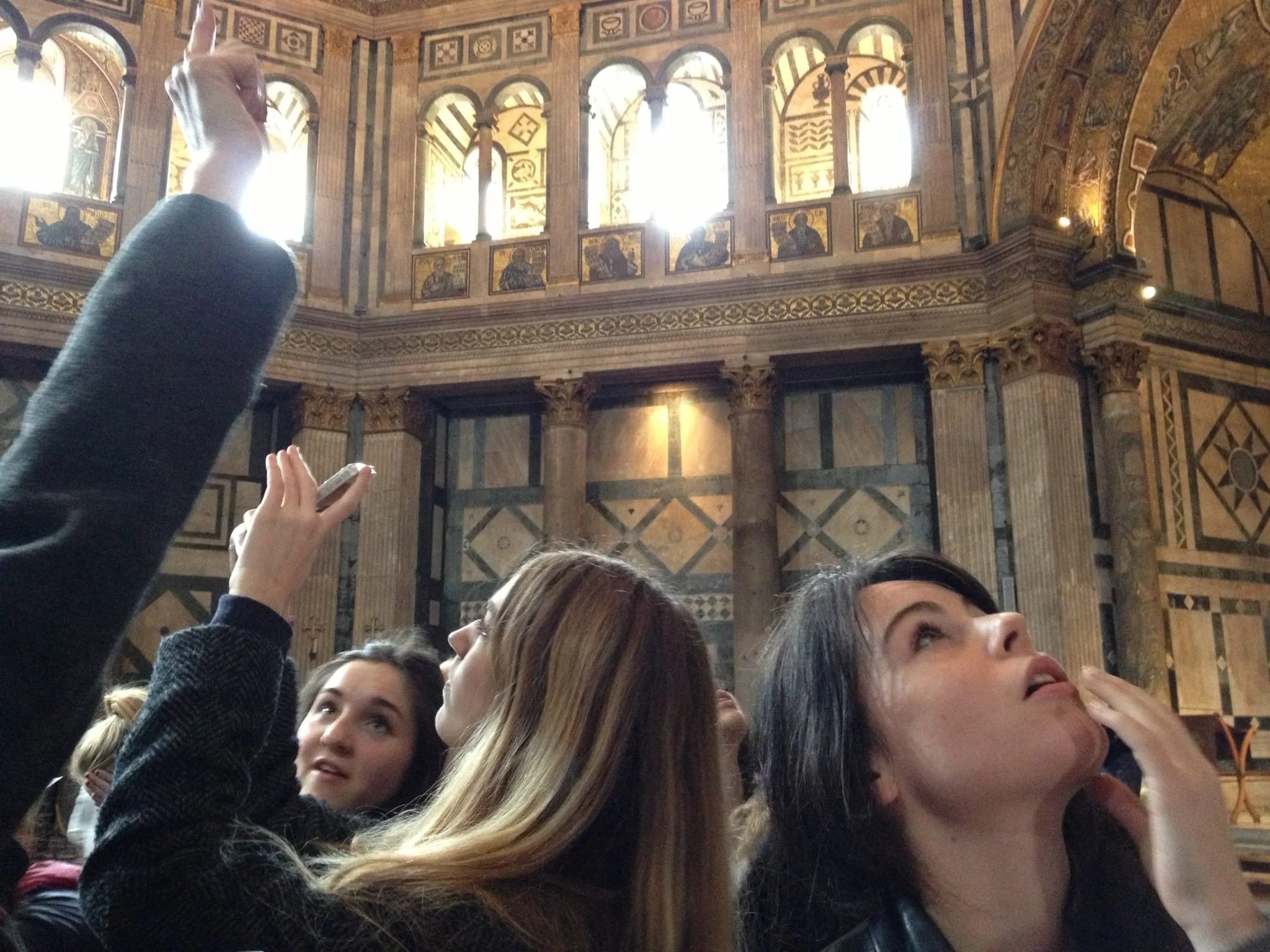
Lectures, Courses & Workshops
“.. a revelation. Katy’s expertise combined with seeing this exquisite work in the flesh was unbeatable.”
-
National Gallery, London
Courtauld Institute & Gallery
Uffizzi, Florence
Bargello, Florence
Soane Museum, London
MoMA, New York
Tate Britain, London
Tate Modern, London
Charles Rennie Mackintosh School of Art, Glasgow
Royal Academy, London
Association of Art Historians Conference, Reading University
Art History Abroad
Starling Studios, Brighton
Cardinal Hume Centre, Westminster, London
-
Godolphin and Latymer School, London
St Paul’s Boys School, London
Queen’s College, London
Christ’s Hospital School, Horsham
MPW, London
King Edward VI, Southampton
Wycombe Abbey, High Wycombe
Hertford Primary School, Brighton
Wye Primary School, Kent
INSEEC Business School, MA Module
-
David Bomberg: Art and Jewish Identity.
Holbein’s “Ambassadors”, History and Symbolism.
Van Eyck’s “Arnolfini Portrait”: Trade and International Relations.
Leonardo da Vinci and the “Virgin of the Rocks”: Symbolism and Meaning.
The Secret Language of Images: A Guide to Symbolism and Meaning in 10 Famous Works.
Italian Renaissance Art and Architecture: Illusion and Revolution.
Modernism in Europe: from Matisse to Picasso and Dali.
Beauty and Fragmentation: The Body in Art.
Identity in Art: Ethnicity, Gender, Nationality and Body Politics.
Nature in Art and Architectural: From Dürer to Ai Wei Wei.
“.. Simply thrilling. Katy’s lecture series provided a deep dive into Leonardo’s life and times. Her flair for story telling, coupled with academic bravura, brought the Italian Renaissance into the lecture theatre. ”
I have been an independent art historian and teacher, facilitator and lecturer since 2006. I write and deliver courses based on my academic research, including short talks in front of works of art at galleries and museums, interactive workshops and study tours.
I teach across periods, from Classical and Renaissance art and architecture, through Modernism and contemporary practices in Europe and North America to global perspectives. Decolonising the art history curriculum in schools has been a particular interest of mine, as well as opening up discussions about gender, ethnic and national identity politics through visual culture.
An interdisciplinary approach is central to my ethos, and I aim to offer a 360 degree immersion into the culture of a period (previously including food, music, theatre, politics and philosophy, scientific advancements and economics), in order to broaden and deepen my students’ understanding of art works studied, and to foster an awareness of interdisciplinary knowledge production.
In addition to lecturing at academic institutions, galleries and museums, I lead mixed ability workshops including primary and secondary school children, neurodiverse and SEN children, visually impaired adults, vulnerable youths, over 60s, and LGBTQ+. I welcome the opportunity to work with and learn from all individuals inspired by art and its histories.
I am constantly refining my working practice to support all individuals in the creative learning process. I aim to offer an inclusive, reflexive environment through listening, observing and challenging my students to discover their creative potential.
“Absolutely amazing. I’d never been to the RA and I hadn’t studied Art History, but Katy drew the ideas out of us in what felt more like a conversation than a lecture. I could bring my own insights to the discussion, and felt really valued. I never realised how much depth & meaning there is to art. And these works in particular really spoke to my family history.”
Sample Lectures & Courses
David Bomberg: Jewish Heritage & Artistic Identity
-
David Bomberg (1890-1957) was a British Modernist. Sadly overlooked during his lifetime, he was one of the most important innovators and teachers of his time (his students included Frank Auerbach and Leon Kossoff).
Art Historian Richard Cork has historically focused on Bomber’s stylistic developments, from the influences of Cubism and Vorticism to an emotive Expressionism at the end of his life, in order to place him within the European Modernist canon.
My research, however, looks at Bomberg as firstly a Jewish artist, asking how his heritage, language and faith, as well as his experience of antisemitism, shaped his choice of subject matter, his style, as well as his ‘outsider’ status within the British art scene.
Leonardo & “The Virgin of the Rocks”
-
This lecture series is based upon my 2018 book, the first monograph dedicated to Leonardo’s famous “Virgin of the Rocks” commission (Cambridge Scholars Publishing).
Leonardo completed fewer than twenty paintings in his lifetime, yet he returned twice to this same mysterious subject. The first version, of c.1482-4, was Leonardo’s magnum opus, catapulting the young artist from obscurity to fame. When, in 1508, he finished the second painting, he was nearing the end of his artistic career and had become an international celebrity. Why did he revisit The Virgin of the Rocks? What was the meaning behind the cavernous subterranean landscape?
Setting the scene in Republican Florence and the humanist court of the Milanese warlord Ludovico Sforza, I unveil the clandestine human dissections, Neo-Platonic philosophy, political turmoil and personal and technical maturation, that inspired the creation of the two masterpieces. This course takes a deep dive into the Italian Renaissance through the lense of one commission and argues that The Virgin of the Rocks holds the key to the greatest philosophical, scientific and personal transformations of Leonardo’s life.
-
"Katy’s lectures felt a bit like a thriller. She kept us gripped throughout. She provided a fascinating, in depth study of Leonardo’s life and the Virgin of the Rocks paintings; a 360 look at historic events, philosophy and politics, artistic and scientific context, which gave excellent coverage and insight to Leonardo’s life and times."
- Joanna, NG Lectures (2019)
"Katy's enthusiastic and scholarly approach to the artistic and cultural history of Renaissance Florence and Milan was coupled with a brisk, engaging pace and approachability, which meant ‘question time’ was open and friendly. She managed to convey complex and sophisticated issues to people with a love of art but no formal training. A thoroughly enjoyable, as well as educational, experience!"
-Mike, NG Lectures (2019)
The Secret Language of Images:
10 Famous Works at the National Gallery
-
This course is an introduction to Art History. Taught in front of 10 works at the National Gallery over a period of 2.5 hours (with time for a coffee break), it can be extended into a series of longer talks in any environment, lecture theatre, classroom or private venue.
In this informal, conversational meeting, I invite you to become an art detective with me. By studying the images and the symbols hidden within each artwork you will learn to unpick their meanings and discover together how they hold the key to a historical moment in time. From gendered power dynamics and international politics in Renaissance Europe, to scientific discoveries in the Enlightenment and the invention of Steam Power in the Victorian era, this will be a tour through history via some of the greatest artworks in the world. Taken in chronological order, this survey will also give participants a sense of developments in artistic style through time, from the Renaissance to Post-Impressionism.
Example works include:
Van Eyck, Arnolfini Portrait, 1434.
Leonardo da Vinci, Virgin of the Rocks, 1508.
Parmigianino, The Vision of St Jerome, 1527.
Holbein, Ambassadors, 1533.
Titian’s Apollo and Daphne, 1538.
Caravaggio, Supper at Emmaus, 1601
Gainsborough, Mr and Mrs Andrews, c.1750.
Turner, Fighting Temeraire, 1844.
George Seurat, Bathers at Asnieres, 1884.
Van Gogh, Sunflowers, 1888.
Beauty and Fragmentation: The Body and its Meaning in Visual Culture.
-
Our obsession with youthful and beautiful bodies has its roots in Classical Antiquity where male-female gender roles within society were visualised in sculpture and enacted in the political sphere. Whilst notions of gender and beauty have become more fluid, we are still often unconsciously bound to or reacting against these ancient stereotypes that lie hidden in plain sight in popular visual culture (from advertising to NHS leaflets), with harmful consequences, particularly for children and teenagers, who are in the process of transformation.
In this lecture we look at the history and meaning of the body-beautiful in art. Starting with the ancient binary we look at the Greek male Doryphorus, to the Renaissance David by Michelangelo and its influence on Nazi propaganda. In contrast we consider the idealised female: the Classical Medici Venus, the Renaissance recasting of the trope by Titian, through to modern examples and contemporary advertising. Finally, in contrast to this often-harmful narrative, we look at how contemporary artists, such as Jenny Saville and Mark Quinn, Nathaniel Mary Quinn and Zanele Muholi have complicated and unbalanced this binary, opening the realm of beauty to encompass bigger body sizes, ethnically diverse beauty, Queer identity, disability aesthetics and ageing bodies.
Through tracking the creation and then destabilising of this historical narrative, the audience will be given the tools and language to critically analyse the body-imagery we see every day, the political and underpinnings of these images, and a starting point from which to navigate their own relationship with their body in the world.
Presented as a short single lecture or a longer series of three, this topic is an important conversation starter for every-body.
Modernism in Europe: 1900-1945.
-
Around the turn of the century the naturalism that had dominated artistic production from Classical Antiquity through the Renaissance and beyond, was challenged. A flattened sense of space, fragmented and illegible forms, non-naturalistic colour palettes and confusing lighting, the new technique of collage, and in some cases surreal subject matter, became part of the vocabulary of the avant-garde. But why? This course unpacks the reasons for these revolutionary developments.
In 1900 Paris was the hub of the art world, and artists gathered to respond to the new challenges of an urban environment, industrialisation and mechanisation and to the changing ways of seeing prompted by developments in photography, Einstein’s Theory of Relativity, X-Rays and the anti-positivist philosophy of Bergson and Poincare. These intellectual and technological changes, combined with a fascination with the “primitive” artifacts arriving from colonised African countries, combined to influence avant-garde works of Matisse and the Fauvists, Picasso and Braque’s Cubism in Paris, and the early phases of German Expressionism in Berlin and Munich. In Milan, a focus on heroic mechanisation fed Boccioni’s muscular Futurism. The horror of the First World War, however, dampened spirits, and Dada and Surrealists, grasped at Freudian theory, Sade and other anarchistic ideologies in their distain for the political systems that had led to the trauma of mechanised warfare, and that seemed to be leading them towards another global crisis.
This course will look at chronological stylistic developments during this period, as well as the philosophical, political, and technological context that underpinned this artistic revolution.
The Italian Renaissance: Florence, Venice & Rome.
-
The Italian Renaissance was one of the most incredible explosions of creativity that has ever occurred in western culture. Defined by Georgio Vasari in his Lives of the Artists (1550) as the ‘rebirth’ of classical literature and learning that occurred in Italy between 1300-1520, in visual art it involved a stylistic shift towards increased anatomical and psychological naturalism, coupled with idealism, greatly aided by the development of oil paint technique and single point linear perspective. This was accompanied by a complex intellectual flourishing that owed a great deal to private and Church patronage, humanist study, as well as national and international politics and identities.
This course will look at the achievements of some of the greatest Italian Renaissance painters, sculptors and architects across three artistic centres: Florence, Rome and Venice. It will trace developments and the individual stylistic output of the Early Renaissance, from Masaccio, Donatello and Brunelleschi in Florence, to Bellini in Venice, through to the flourishing of the High Renaissance in Rome with Michelangelo and Raphael and in Venice with Titian and Giorgione. The impact of the unique cultural and geographical contexts of these different locations, coupled with their different systems of patronage and political structures, will be interrogated as reflected in the artworks produced there.
Identity: Gender, Ethnicity and Body Politics
-
Art has always played a vital part in the expression of identity. Works of art both express and shape our understanding of gender, nationality, ethnicity, both as individuals and as societies.
This course looks at in-depth case studies based on gender and ethnic identity through the genres of portraiture and the nude.
Case studies are considered in terms of historical, political and economic context of their artistic production, in order to get a sense of the nuanced and complex meanings embedded in each work. For example, Van Eyck’s Northern Renaissance “Arnolfi Portrait” (National Gallery, 1434) is discussed as an expression of the patron and sitter’s wealth from trade via the Silk Route and Hanseatic League, the economic links with the Medici in Florence, and gender power dynamics at the Burgundian Court. Comparison’s with, for example, Frida Kahlo’s Modern self-portraits, and Mark Quinn’s conceptual work, “Self”, bring into discussion the changing function of portraiture over time, the importance of stylistic decisions when conveying meaning, and the influences of patronage versus self-expression.
When discussing ethnicity, Van Dyck’s “William Fielding”, 1633-4 (National Gallery) offers an example of racialised, white ethnocentric identity, so sadly common in Britain at that time, and might be compared to Yinka Shonebare’s “Ship in a Bottle”, 2010 (Greenwich Maritime Museum), as a celebration of diversity and multiculturalism in Britain today. The study of gender identity will start with a discussion of the Classical canon, Doryphorus’ idealised Polycleitus and the Medici Venus (300BCE), and might be contrasted with Jenny Saville’s “Propped” (2010) as a fierce confrontation with patriarchal beauty standards, and Zanele Muholi’s “Self-Portraits”, 2015-16 (Tate Modern), as an exploration of Queer identity.
Nature in Art and Architecture
-
A source of inspiration, a symbol of belonging or as an ideal of perfection, the natural world has always played a vital part in shaping our art and architecture. This course is designed as an introduction to art history with a focus on the ways in which the motifs, messages and materials of nature have been used across time and place.
Through in-depth case studies and comparisons, various subject and genres are considered including the depiction of animals, plants, landscape and seascape, the depiction of the elements, the relationship between man and nature, and the influence of architecture inspired by natural forms.
From the Classical Khmer architecture of the 11th century Ankor Wat, the great “Temple Mountain”, inspired by the Cambodian geography and Hindu animism, to the sublime arches and sculptural flora and fauna of Gaudi’s Sagrada Familia in Barcelona, the power of nature as influence, and as bearer of religious symbolic meaning, is compared across faiths and continents. Meanwhile, from the superb naturalism of Norther Renaissance artist, Albrecht Dürer, to the Chinese conceptualist, Ai Wei Wei, an understanding of the importance of the depiction of natural forms as scientific documentation, political symbol, and in personal expression is developed.
At a time when our global climate and eco-system is in great danger, this course is a poignant reminder that the natural world has been an essential part of human culture and belonging, as expressed through art, for millennia and across continents.
Katy‘s passion for Art History is infectious. She studied Art History at Cambridge University (BA) and the Courtauld Institute of Art (MA). She went on to work at MoMA in New York, Tate Britain, London, the Soane Museum, London, and the Charles Rennie Mackintosh School of Art, Glasgow. She has also lectured at the National Gallery, London and has authored several books, including ‘Leonardo and the Virgin of the Rocks’ (Cambridge Scholars Publishing).
Katy has over fifteen years’ experience teaching Art History at A-Level, as well as being Head of Department, at some of the top Independent Schools in the country, including Godolphin and Latymer, Queen’s College and Christ’s Hospital. She is an A-Level Examiner and has also been Oxbridge Coordinator and wrote the definitive guide to ‘Getting into Oxford and Cambridge’ for 2011/12.
In 2022 she founded the School of Art History and Cultural Studies, and as its director Katy gives lectures and runs courses for adult learners, and leads brilliant tours to European cultural centres, including Florence. Since 2023 she has been presenting a documentary on Leonardo da Vinci.
Get in touch
To get in touch with any questions or enquiries, please complete the form below or email me. I look forward to hearing from you.





